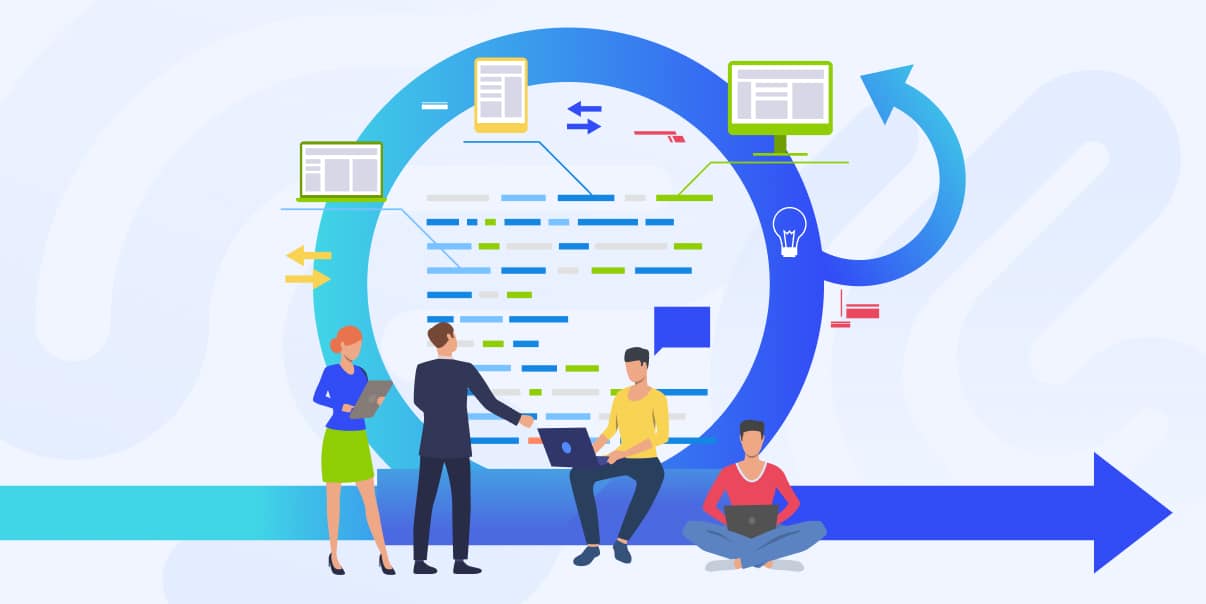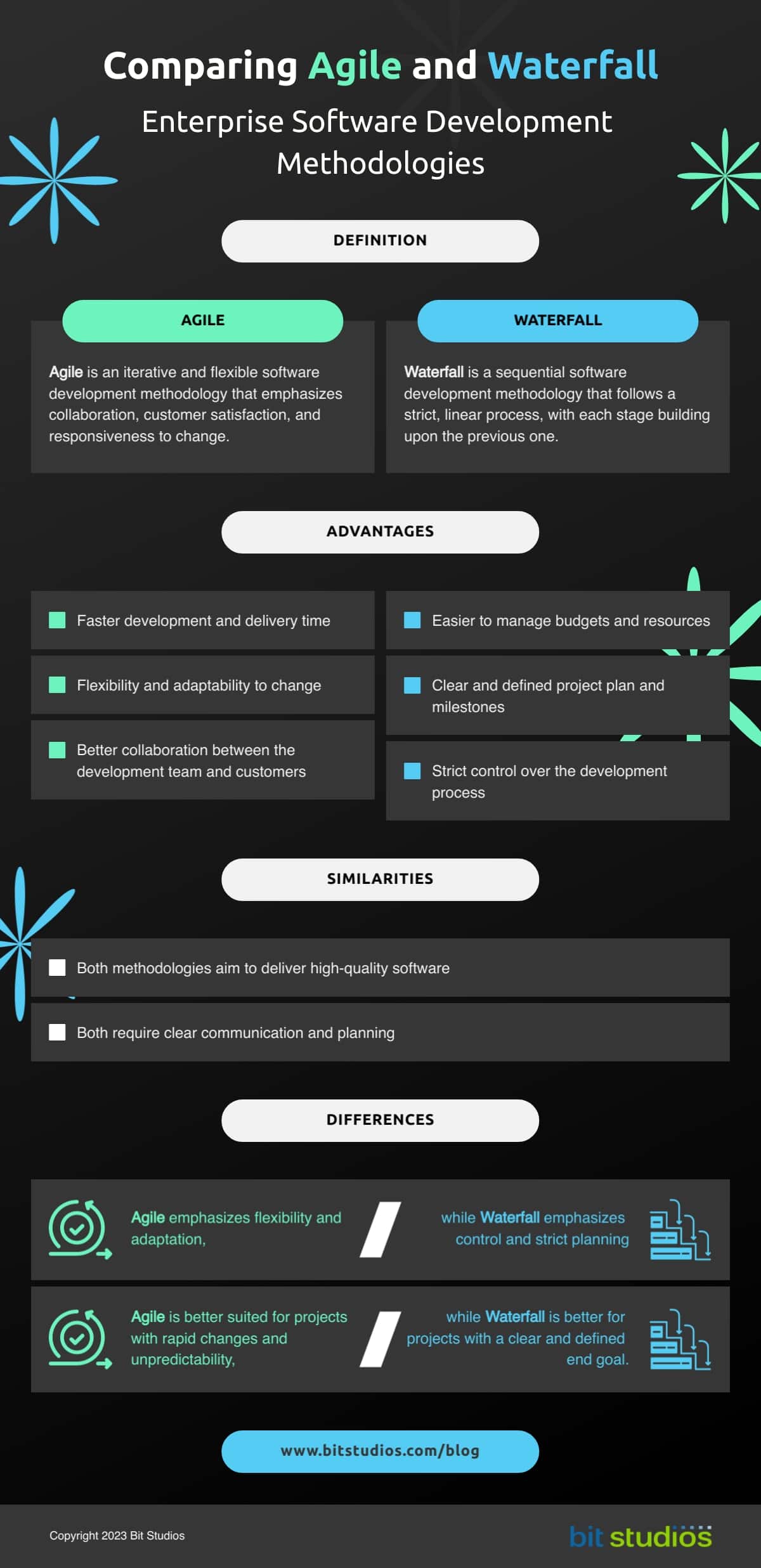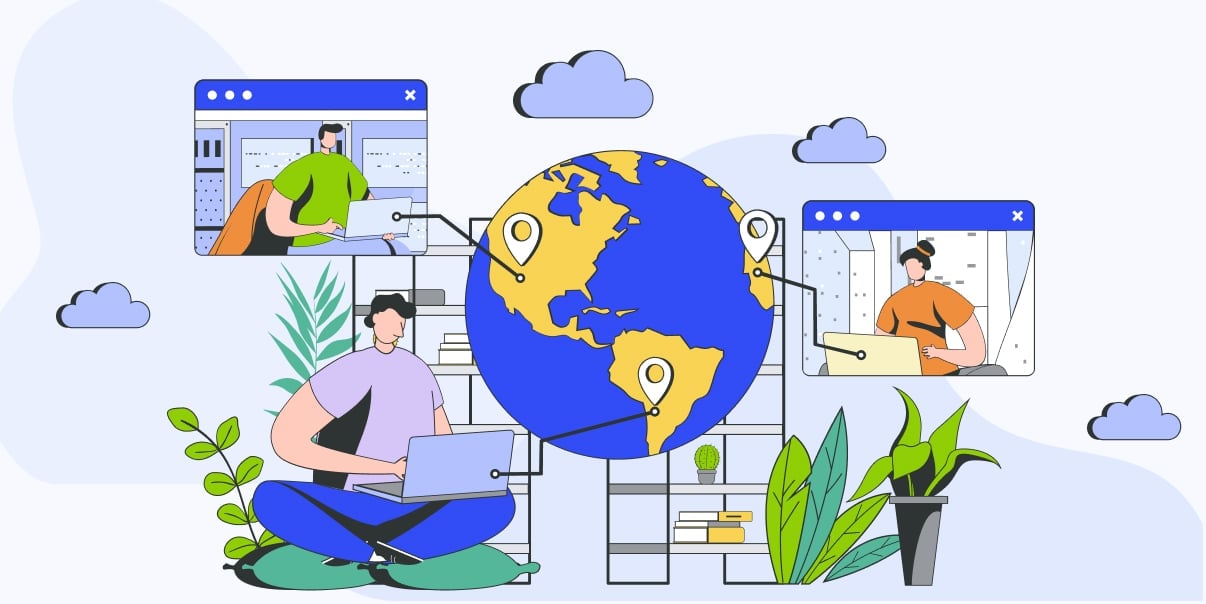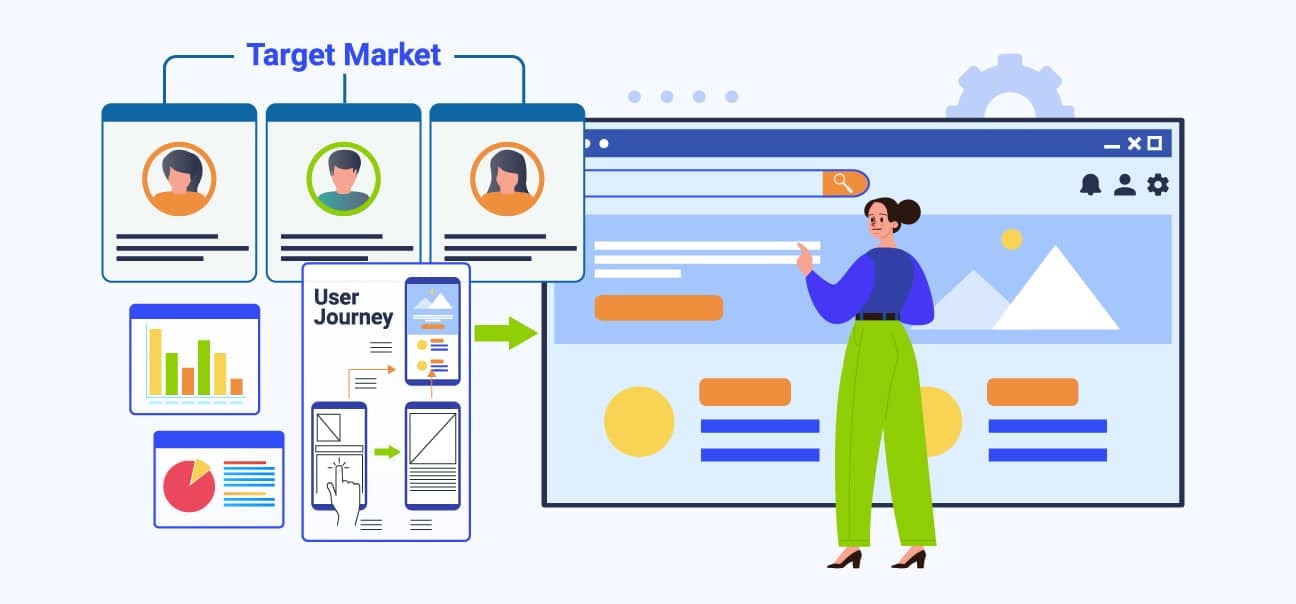Agile vs. Waterfall: Which Enterprise Software Development Process Is Right for You?

Choosing the right software development approach for your enterprise can make all the difference in terms of time, cost, and quality. Two popular approaches for today’s software development are Agile and Waterfall. Before you decide on which one is best for you, it’s essential to understand the advantages and disadvantages each methodology offers. From scalability to flexibility, discover which approach has the features your project needs.
This article will help you determine which development approach best fits your custom enterprise software. We’ll define each methodology and review the pros and cons of each so you can make an informed decision.
What Is Enterprise Software Development?
Enterprise software development is the process of creating large custom apps for businesses. These applications help automate processes, manage data, and provide quick access to information. They are often more complex than regular applications because of the scope of the organization they serve. Enterprise applications may include features such as artificial intelligence or machine learning algorithms. AI and ML help boost productivity levels for the business. When developing software, developers must consider the organization’s size, needs, and requirements.
Types of Custom Enterprise Software
When it comes to developing custom enterprise software, there are many different types that you can use. Each type of software offers unique features and benefits that can help businesses streamline their processes and increase productivity.
Customer Relationship Management (CRM)
CRM stands for Customer Relationship Management. It is software that helps businesses stay organized and track their customers. You can use a CRM to keep track of customer information and orders. CRMs can even help create marketing campaigns.
Accounting and Financial Software
Accounting and financial software help businesses keep track of money. It can help you manage budgets, track expenses, and save money.
Project Management Systems
Project management systems help businesses keep track of projects. It can remind people about tasks, help them plan what they need to do, and track how much time they spend on each project.
Enterprise Resource Planning (ERP) Systems
Enterprise Resource Planning (ERP) Systems help businesses manage their resources. This technology helps keep track of important information, like tasks and expenses, so that companies can be more organized and productive.
Business Intelligence (BI) Tools
Business Intelligence (BI) Tools help businesses make sound business decisions. It collects data, like tasks and expenses, and creates reports to show how well the company is doing. These tools help businesses make intelligent decisions about what they should do next.
Workflow Automation
Workflow automation tools help you keep track of tasks, like what you need to do and when, so that you finish everything on time. They also remember how much time you spend doing each one so that you can use it to make the process faster and more efficient.
Before building any enterprise tool, you should have a well-defined process. Read on to understand why.
Importance of a Well-Defined Process in Enterprise Software Development
A well-defined process is essential to ensure the project’s success. It should also be flexible enough to accommodate changes as needed.
To define the process well, developers should set a development plan and timeline to ensure the project meets its goals. Additionally, they should define clear roles for everyone involved and create a detailed list of requirements. Developers should also use version control systems such as Git or Subversion to keep track of their code as they work on it. Finally, they should perform thorough testing to identify and fix problems before launch.
Comparing Agile and Waterfall Methodologies
Agile and Waterfall are the most popular approaches to building enterprise software. Both have their advantages and drawbacks. Project managers need to understand the differences between them before making a decision about which one to use.
Agile focuses on delivering projects quickly with frequent feedback from stakeholders. Waterfall favors planning and documentation during each stage of the software development process.
Both methods are successful in many different industries. They require very different skill sets and ways of working. Let’s compare these two approaches in detail so that you can decide which one is best suited for your enterprise software project.

Agile Development
Agile development is a way of creating complex software applications for businesses. It involves quickly delivering projects with lots of feedback from everyone involved. This approach focuses on getting the product to the customer as soon as possible, so it needs people who can move fast and think on their feet.
Companies use this model to build new enterprise software systems because it allows them to iterate and quickly improve their product. It also provides the flexibility needed to create a custom solution tailored to the customer’s needs.
Pros:
- Quick iterations. Agile allows developers to quickly iterate on the product and rapidly get stakeholders’ feedback.
- Flexible. Agile lets teams adjust their plans as needed, so they can focus on delivering the right features for their customers.
- More efficient and cost-effective. Agile lets teams work faster and more efficiently due to its iterative process.
Cons:
- It is challenging to manage. Agile requires much communication and can be tough to run.
- It requires discipline. Agile processes need developers to remain disciplined to stay on track with the project timeline.
Waterfall Development
Waterfall development is where the team completes each step in order, one after the other. It allows for precise planning and tracking of progress.
Businesses use the waterfall model because of its structure. Its sequential order ensures that the development team manages the risks effectively. It also makes it easier to identify potential problems earlier in the process, which saves time and money in the long run.
Pros:
- Defined Process. The waterfall approach provides a clear and defined path for the project. This model makes planning, tracking progress, and identifying needed resources easier.
- Transparent time frames. The waterfall approach establishes clear deadlines for each phase of the process. It helps to ensure that the development team completes the projects on time.
- Reduced Risks. Completing each phase in order lessens the risk that something will go wrong.
Cons:
- It is challenging to change requirements. Once you set a project in motion, it can be hard to make changes or adjustments without compromising the entire process.
Factors To Consider When Choosing an Enterprise Software Development Process
A proper development model is vital to ensure the success of your enterprise projects. Your choice can make or break your enterprise solution. Here are the factors you need to be aware of to make the right decision. Consider these factors before finalizing which development route you take.
Size and Complexity of the Project
Knowing the size and complexity of a software project is crucial to deciding which approach will be most efficient. Determining which fits the project’s scope and complexity can save significant resources in the long run.
Needs of the Business and Stakeholders
Take a closer look into your business needs. Consider how your chosen development model can affect your stakeholders. A thorough understanding of the end user’s requirements can ensure that the product meets their needs and expectations.
Availability of Resources and Expertise
An enterprise software application is highly complex. It requires a team with advanced technical expertise. Suppose you need to have the necessary resources in-house. In that case, you may need to outsource to a software development company. Do your research and background checks. The success or failure of your enterprise app can depend heavily on your service provider. Ensure that your selected technology stack is well-suited for the enterprise app that you are looking to build. The right combination of internal resources, external experts, and technologies will help put you on the path toward developing a successful enterprise app.
Risk tolerance
Building enterprise apps involves addressing complex data and integrating internal processes. Such processes include extensive testing measures, tightened security protocols, and a reliable application support system. Enterprise solutions are typically huge investments for long-term use. It would be best to have the right mix of risk mitigation strategies, as it is crucial in the process.
Tips for Determining the Best Development Approach for Your Enterprise Software Development Project
Selecting the ideal development process is crucial as businesses develop enterprise software. The right choice of approach can make or break an enterprise software project. Here are some valuable tips for determining the best direction for your enterprise software project.
Identify Your Business Goals
Before diving into the development process, clearly defining your business goals and objectives is essential. Ask yourself the following:
- What goals do you want to achieve with the software?
- What challenges are you trying to solve?
- How will this help improve customer experience?
Once you have identified the business goal, it’s time for the development team to start the process.
Evaluate the Size and Complexity of the Project
After you have identified your business goals, it’s time to determine the specific scope of your enterprise project. Take the following factors into account:
- Project Scope
- Timeline
- Resources
- Budget
Doing so will give you an overview of what you must prioritize to ensure a smooth development process.
Consider the Culture and Values of Your Organization
Every company has its unique set of values that it should consider. It will help if you look back at them to ensure that your path is correct.
Understand the Needs and Preferences of Your Team
The project team is the backbone of any successful enterprise software development process. The project manager should ensure that the software development team has what they need to develop software. Doing so will enable them to create an environment that encourages collaboration and communication.
Seek Advice From Experts and Practitioners
Getting advice from experts ensures that the development approach you choose is the perfect fit. Seek out industry specialists who have experience in building custom mobile software applications. They can offer valuable insight into the most suitable methods for your needs.
Implementing an Agile Enterprise Software Development Process
Learning the fundamentals of agile-driven software development would be best to reap its benefits. Knowing its core principles, methodologies, and best practices can ensure you can do the job well.
Agile Principles and Values
- Individuals and Interactions. This principle emphasizes that companies should value individuals, collective effort, and interactions between stakeholders over processes and tools.
- Working Software. Working software should be the primary measure of progress for any development project.
- Customer Collaboration. Agile relies heavily on customer collaboration throughout the entire project lifecycle. It ensures that the result meets their needs.
- Responding to Change. Companies should embrace changes as part of agile. They should accept changes even if the development has begun.
- Sustainable Development. Agile projects should strive for sustainable development practices. These practices ensure that each member maintains a healthy balance between work and personal life commitments.
Common Agile Methodologies
Here are the most common agile methodologies.
- Scrum. Scrum is an iterative, incremental framework that helps teams focus on delivering the highest-value items first. It organizes tasks into short, iterative cycles called sprints. Then, it emphasizes collaboration and communication between team members to ensure successful completion.
- Kanban. Kanban is a visual project management system. It emphasizes continuous improvement and workflow optimization. Kanban uses a series of boards and cards to track progress. This method visually illustrates which part of the project needs attention to keep projects moving forward.
- Lean. Lean is about streamlining business processes and eliminating waste wherever possible. Its core focus is maximizing customer value through constant feedback loops and reducing waste by first focusing on the most critical tasks.
Best Practices for Agile Enterprise Software Development
Companies need to understand the principles of agile methodology and follow best practices when implementing it. Here are some tips for effective agile enterprise software development:
- Focus on customer feedback. Incorporating feedback into the process is critical to ensure that the end product meets their needs and expectations.
- Prioritization of tasks. Agile software development teams should prioritize tasks based on their value to the customer. Doing so will help ensure that teams are working on essential items first, leading to faster delivery times and better results.
- Communication and collaboration. Effective communication and collaboration between team members are necessary for successful agile projects. Everyone needs to be able to communicate openly and feel comfortable voicing ideas or concerns. Doing so will facilitate a productive work environment.
- Test-driven development. Test-driven development (TDD) helps ensure that the developers write code correctly from the beginning. It saves time in the long run by reducing bugs and other issues while testing.
- Automation. Automating business processes like building pipelines and deployments can help streamline development cycles. It also reduces errors caused by manual intervention.
Implementing Waterfall Enterprise Software Development
The waterfall approach is a popular methodology for building enterprise systems. Knowing its phases and best practices is essential to implement it successfully.
Waterfall Phases
The Waterfall model is a sequential process that consists of the following phases:
- Planning. The planning phase involves gathering and analyzing relevant information. The team creates a roadmap for the project and determines what they need to do.
- Analysis. During the analysis phase, the project manager breaks down the requirements into individual tasks and user stories. Doing so helps ensure that all stakeholders clearly understand the project scope and objectives.
- Design. In this stage, designers create detailed plans outlining how the system should work and look. The plans include mock-ups, diagrams, and prototypes.
- Implementation. Once the team finalizes the design, the developers write code to build the system.
- Testing. In this stage, testers use automated tools and manual testing procedures. Testing ensures that the software is functioning correctly.
- Deployment. The team deploys the application into an environment where end users or customers use it for real-world scenarios.
Best Practices for Waterfall Enterprise Software Development
Enterprise app development using the waterfall model requires careful planning and execution. Here are some best practices for a successful outcome.
- Define requirements and objectives. Before starting, it is crucial to define the expected outcomes. Doing so will ensure that each step the development team takes aligns with the ultimate goal.
- Follow a sequential process. The Waterfall model uses a sequential process. The development team must complete each phase before moving on to the next one. This process ensures that the group meets tasks orderly. It can help reduce errors or inconsistencies.
- Documentation. Documenting all phases to guide future development or maintenance tasks is essential. Documentation should include detailed descriptions of functionality, code samples, screenshots, and diagrams.
- Prioritize tasks. Prioritizing tasks helps team members focus on the most critical pieces of work first. It allows them to finish faster and more efficiently.
- Risk management. Proper risk management is a must throughout the development process. It predicts potential issues and gives the team ideas on how to mitigate them if they occur.
- Testing. Thorough testing ensures that the software architecture functions correctly in real-world scenarios.
Challenges and Considerations in Enterprise Software Development
Developing custom enterprise software can be a daunting task. Developers must consider various factors during the design and development process. Here are some of the challenges and considerations you should keep in mind.
Time Constraints
One of the main challenges with enterprise software development is often time constraints. Development teams need to complete the enterprise software system within the timeframe. It can be challenging to ensure that they maintain the quality and accuracy of the process.
Balancing Resources
Another challenge is finding the right balance between utilizing internal and external resources. It is essential to review the pros and cons of each option to ensure that they take the most efficient and cost-effective approach.
Managing Scope and Changes
As projects progress, it is common for scope changes to occur. It is vital to manage these changes and ensure that the result meets the project’s initial objectives.
Ensuring Quality and Reliability
The software must be high quality and meet users’ expectations to succeed. Putting quality assurance measures in place throughout development can be costly, but it is worth it.
Maintaining Effective Communication and Collaboration
Effective communication and collaboration between all stakeholders are essential for a successful enterprise software solution. Set up systems that allow for clear communication, including updates on progress and changes.
Conclusion
Understanding agile and Waterfall development is essential to decide which is suitable for your project. Both approaches have their strengths and weaknesses. You must choose the one that will work best for your custom software. With careful planning and execution, the enterprise custom software solution can be successful.
Need help getting started with your next custom software development project? BIT Studios has a team of experienced developers who can assist you with every step. Contact us today to learn how we can help you succeed.
We’re BIT Studios!
At BIT Studios we specialize in designing, building, shipping, and scaling beautiful, usable products with blazing-fast efficiency



